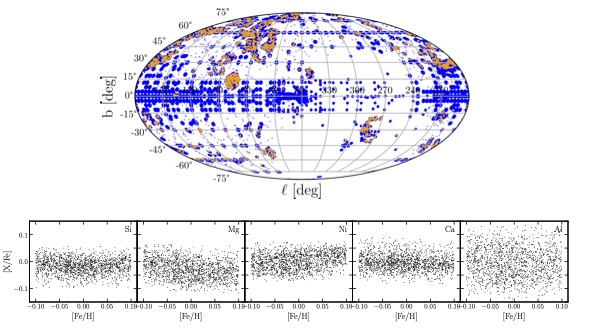Scientists seem to have come up with a new parlor game – how many ways can we potentially detect exoplanets? The two most common methods, the transit method and the Doppler method, each have their own problems. Alternative methods are starting to sprout up, and a new one was recently proposed by Jacob Nibauer, an undergraduate student in the University of Pennsylvania’s Department of Physics and Astronomy. His suggestion: look at a star’s chemical composition. And his findings after analyzing data on some 1,500 stars hold some surprises.
Spectroscopy allows scientists to directly collect data on the chemical composition of stars. Mr. Nibauer’s method took into account that stars and planets form from the same nebular material. Given that the chemical compositions of that material can be estimated before a star is formed, if the star itself happens to be lacking some of the material that would be used to make rocky planets, it’s a pretty strong indicator that there are in fact rocky planets orbiting that star.
To prove this theory, Mr. Nibauer used data from APOGEE-2, part of the Sloan Digital Sky Survey, and focused on 5 different elements prevalent in rocky planets whose chemical composition was in the APOGEE-2 data. He then applied a statistical tool called Bayesian analysis to separate types of stars in the data set into either a regular category, where the star still has the expected amount of “refractory” (i.e. rock forming) elements that would be expected from the nebular cloud, or a “depleted” category where the concentrations are less than expected.
Interestingly, the data showed that most stars in the survey were actually Sun-like in their chemical composition, falling into the “depleted” category from their lack of refractory materials. Previous studies of stars’ chemical compositions showed the Sun as an outlier, but may have been biased in that they used some characteristic of the Sun itself as a sorting mechanism. But the methodology of categorizing the two groups before analyzing the Sun, and then slotting our nearest star into the appropriately categorized group, is a much more unbiased approach.

Credit: Jacob Nibauer
Even with the elimination of that bias, there are still plenty of unanswered questions in this research. So far, there hasn’t been any clear evidence that links “depleted” stars to rocky planets more than non-depleted ones. Additionally, even 1500 stars is a relatively small sample size given the total number of stars in the galaxy. As more data is collected on both exoplanets themselves and of the chemical signature of stars, it will build a clearer picture of what, if any, relationship there is between the presence of these rock forming minerals and that of any rocky planets in these extrasolar systems.
Learn More:
UPenn – Connecting a star’s chemical composition and planet formation
The Astrophysical Journal – Statistics of the Chemical Composition of Solar Analog Stars and Links to Planet Formation
UT – What are Stars Made Of?

